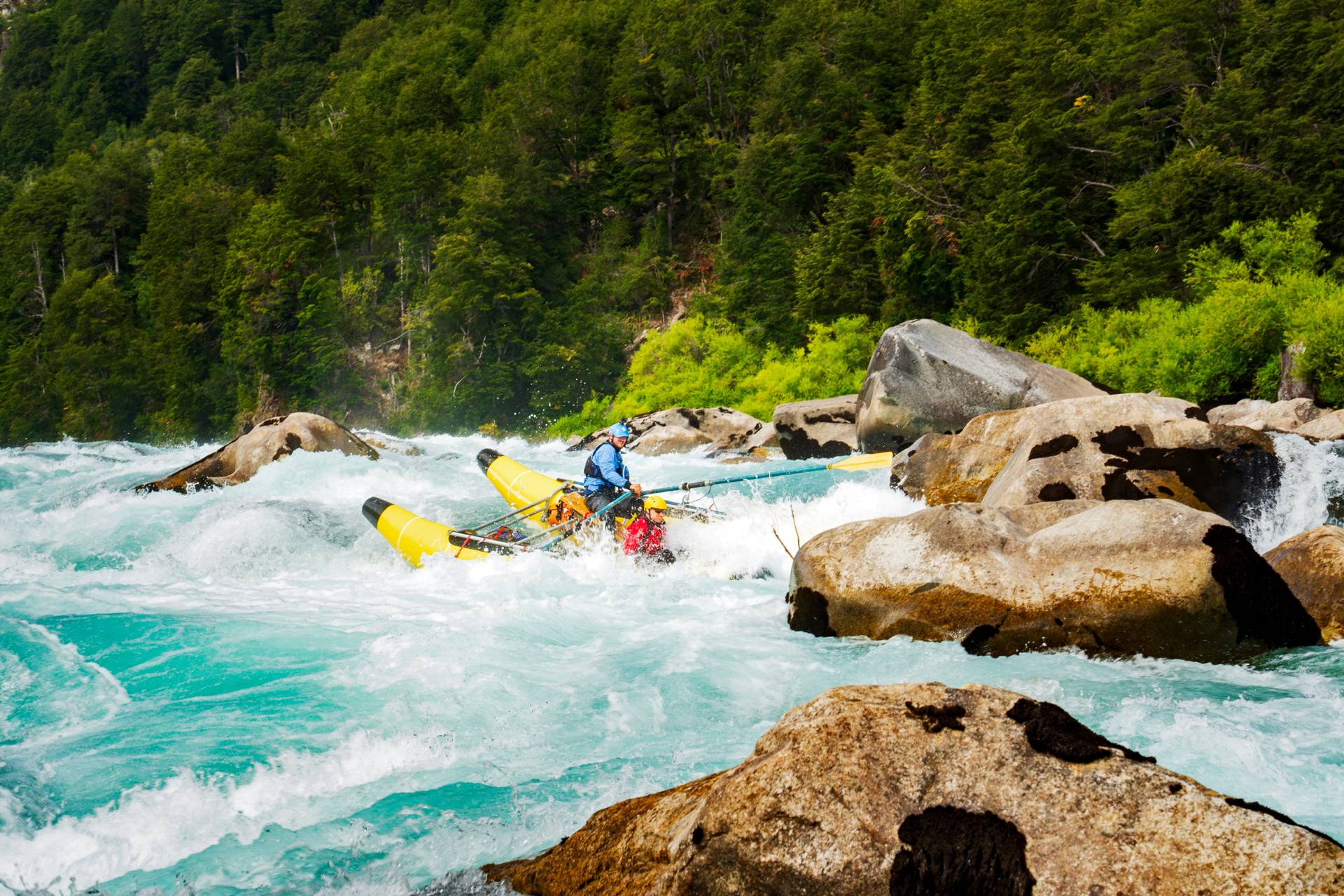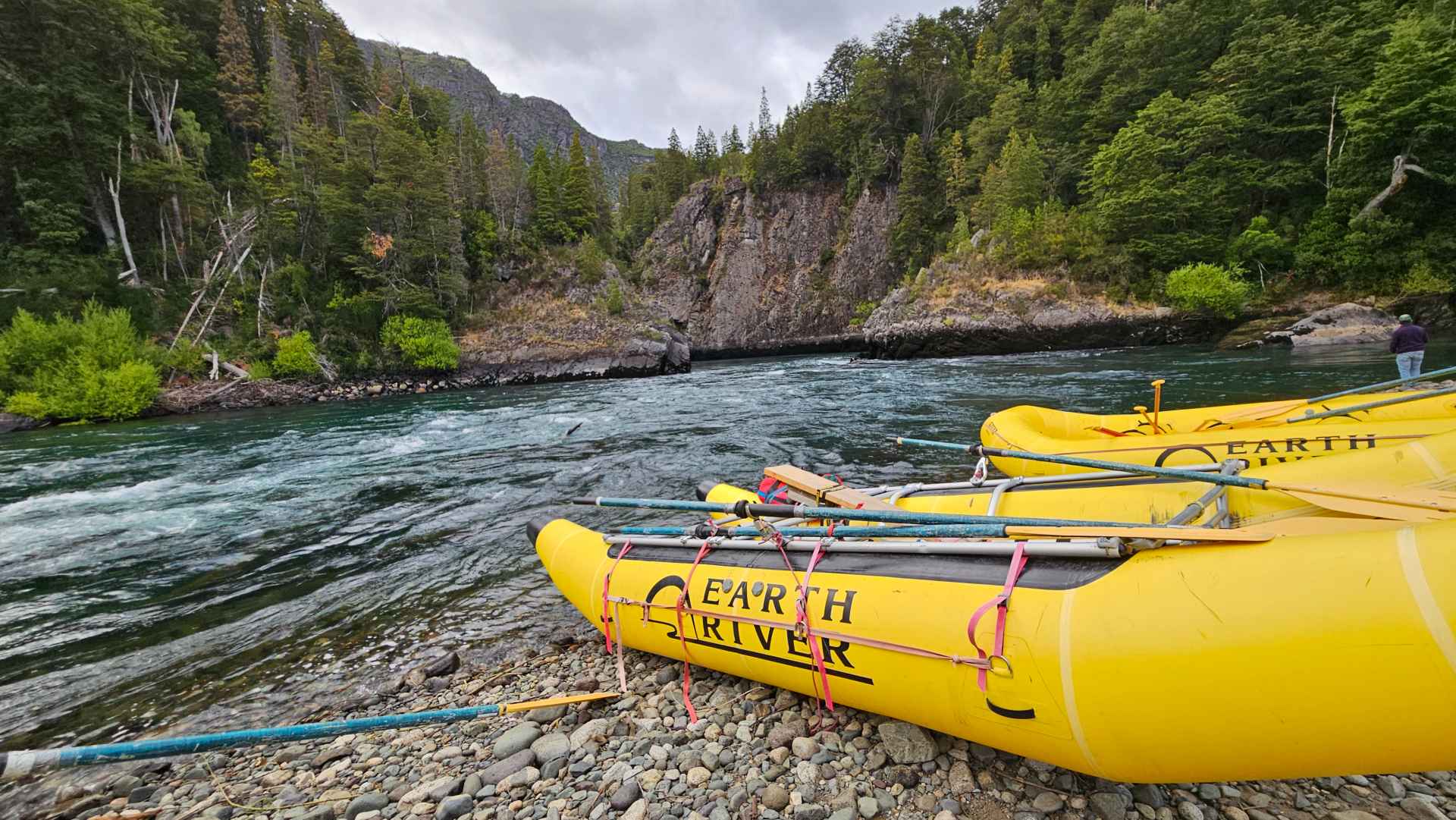A Lot Has Changed in the 35 Years Since Earth River Pioneered Rafting On the Futaleufu In the Early 1990s.
The two most important developments that have opened the Futaleufu River to everyone—regardless of age, ability, or whitewater experience—are: first, the establishment of trails and primitive dirt roads, which make it easy to walk or be driven around the more challenging sections of the river; and second, the replacement of the safety kayak with the safety cataraft as the primary rescue craft on the Futaleufu. What was once solely a challenging expedition for the few, has been transformed into a multi-sport adventure suitable for anyone with a spirit for adventure
How An Expedition in Nepal Changed Whitewater Safety on the Futaleufu.
In the early 1990s our brochure listed the Futaleufu river as a serious whitewater expedition. Thorough guest vetting started in the office. Participants were required to be in excellent physical condition, of a certain age, and to have previously run a challenging whitewater river. Getting down the river took a week, as more time was spent scouting rapids than in the boats. There was no option to walk or be driven around difficult sections and no time for additional multi-sport activities. Once participants reached the river, they did a compulsory flip drill and a two-hour whitewater training session which ended with a mandatory swim test. Rather than float on their backs with their feet up in a defensive position, swimmers were instructed to do the crawl and “self-rescue”. At the time, safety kayaks were the industry standard for rescuing people on difficult rivers.
 If We Can’t Protect Our Clients, What Are We Doing Here?
If We Can’t Protect Our Clients, What Are We Doing Here?
In 1993, I was guiding the second raft on one of these early Futaleufú trips. We pulled over to look from shore at the first rapid in sheer-walled Inferno Canyon. We decided to run one boat at a time. I watched as the first boat missed the line slightly and flipped. One by one, the safety kayakers grabbed the swimmers. By the time everyone was rescued, they were downstream and out of sight. The sheer walls made it impossible for the kayakers to come back up and set safety for us. Attempting to evacuate my group from the canyon was riskier than running the rapid without protection. Reluctantly, I ran the rapid without any problems. The incident—and the dilemma it presented—preoccupied me, and I contemplated giving up the Futaleufu altogether.
The Chance Incident That Changed Everything.
Later that year I traveled to Nepal to do an expedition on the recently opened Karnali River. Dave Allardice, whose company Ultimate Descents pioneered a number of rivers in Nepal, invited me to join one of his expeditions. I brought an agile, stable two-pontoon, 15 foot cataraft to row from the U.S.. I had no idea how important that cataraft would end up being. With a small army of local sherpas carrying the gear, we trekked three days through the Nepalese lowlands to the put-in.
The trip was uneventful until the final day, when a small paddle raft carrying a guide and a client accidentally entered a minor rapid on river right—the wrong side of the river—where the swift current began sweeping them toward a hollowed-out wall on a 90-degree left bend. Their only recourse from being sucked under the wall was to catch a small eddy of still water carved into the wall directly upstream of the treacherous spot. The strong current made it impossible to paddle the raft out of the eddy and back across the river without being stuffed under the wall. In all my years of guiding I had never seen a situation like this. They were safe but trapped.
 The rest of us pulled over on the other side of the river to survey the situation. The cliff above them was too high to climb and there was no way to reach them with a rope. The only option was to send a safety kayaker into the eddy and have the rafters abandon the boat one by one, ferrying each person across on the back of the kayak and returning for the next.
The rest of us pulled over on the other side of the river to survey the situation. The cliff above them was too high to climb and there was no way to reach them with a rope. The only option was to send a safety kayaker into the eddy and have the rafters abandon the boat one by one, ferrying each person across on the back of the kayak and returning for the next.
The safety kayaker paddled across the river and caught the eddy. One of the marooned rafters lowered themselves into the water and grabbed onto the back of the kayak. They pulled out into the current. The person holding on to the kayak created so much drag that they made little progress, and the swift current instantly began sweeping them toward the undercut wall. The kayaker quickly retreated back into the eddy. We were running out of options. It was possible that a helicopter could drop a basket down, but we were a long way from civiliaztion, helicopters were scarce and this was also years before the advent of the satellite phone.
As a last resort, I volunteered to try with my cataraft. After catching the eddy, I had them both abandon the raft and climb up on to my cataraft tubes. I instructed them to lie on their stomachs, and raise their feet out of the water. Using a sharp upstream angle, I charged into the current. Unlike the kayak, the cataraft—unburdened by drag—easily maintained the upstream ferry angle, allowing me to pull away from the wall and cross. It was a stroke of luck that the cataraft was even on the trip. Without it, the small raft would have been forced to attempt the crossing on their own, which could have ended in disaster. Any experienced rower could have rescued them with a cataraft. The combination of the greater power generated by long oars compared to paddles, the agility and speed provided by gliding on two pontoons, and the absence of drag from someone in the water made the rescue possible. In that serendipitous moment in Nepal, the “safety cataraft” was born.
Safety Catarafts introduced On The Futaleufu
When I got home, I ordered two large catarafts and custom-designed rowing frames with raised front decks that sat just a few inches above the water. These “safety cats” would be positioned at the bottom of rapids. If someone fell in, the cat could be quickly rowed into the current with its low front deck facing upstream. The swimmer would float between the pontoons and slide right onto the deck—often without the even having to let go of the oars. Unlike a safety kayak, the cataraft could pick up multiple people at once, with no drag from anyone in the water.

On the first trip of the 1994 season, we took a charter group from Chicago that had done the Bio Bio River with us the year before. I rowed one of the two safety catarafts. We had some swimmers in one of the rapids, and the safety catarafts effortlessly picked them up. The “safety cat” had been inaugurated.
 Dedication To Safety
Dedication To Safety
Earth River’s commitment to client safety didn’t begin or end with the invention of the safety cataraft. It’s something ingrained in our 35-year history and has been passed down to my sons, Cade and Teal, who guide every trip. If you join an Earth River trip, regardless of your age or ability, it will be evident in the first rapid that you’re in good hands.”
By Eric Hertz
